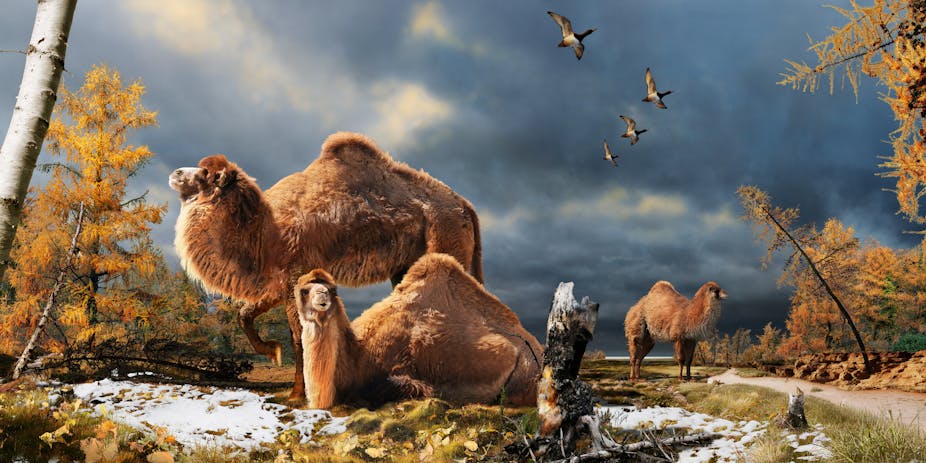Ancient camels up to 29% larger than their modern-day cousins may have roamed the High Arctic of Canada around 3.5 million years ago, according to a new study of a fossil found in the region.
The study, published in the journal Nature Communications, said that camels originated in North America and wandered to Eurasia over a land bridge between Alaska and Russia known as the Bering Isthmus.
But a fresh analysis of fossil fragments of a large tibia leg bone found in the Ellesmere Island region of Canada suggests the North American camels may have been living up to 1200km further north than previously thought.
“Informed by the cortical thickness and surficial dimensions the Ellesmere tibia is estimated to have been approximately 575mm in length, 29% larger than that of modern camels,” the paper said.
The area at that time, in the mid-Pliocene epoch, was probably substantially warmer than it currently is and may have been forested, the researchers said.
However, the researchers also said it is likely that the Ellesmere camels survived winters with very low temperatures and six months of darkness.
“Some specialised traits seen in modern camels may also have served well in an Arctic realm. For example their wide flat feet function well on soft substrates, such as sand or snow. Their iconic hump(s), containing fat, also may have been adaptive. As seen in high-latitude ungulates today, fat deposits could have been critically important for allowing populations to survive and reproduce in harsh climates characterised by six month long, cold, winters.”
Dr Mike Lee, a Senior Research Scientist in Evolutionary Biology at the University of Adelaide, said the new find “greatly extends the range of Paracamelus, the genus that is likely ancestral to modern camels, into the Arctic.”
“However, Paracamelus also ranged across much of Europe, Africa and Asia, and modern camels could have evolved in any of these areas,” he said.
“Thus, the new find doesn’t prove camels evolved in the Arctic, though it does demonstrate that the ancestors of camels were more broadly distributed than previously thought.”
But lead researcher on the project, Natalia Rybczynski from the Department of Palaeobiology at the Canadian Museum of Nature in Ottawa and an Adjunct Professor at Canada’s Carleton University said “it is most likely that Paracamelus, or its nearest relative, evolved in the northern latitudes of North America, before dispersing westward via Beringia to the Old World.”
Professor Mark Elgar, an evolutionary biologist the University of Melbourne said fossil scientists sometimes take a lot of liberty when joining the dots because they have so few clues with which to work.
“I’m often more bemused than excited about this kind of study – we go to extraordinary lengths, using all kinds of sophisticated molecular and statistical techniques, to generate phylogenies of extant species, while making similar evolutionary inferences of extinct species seems to require only a few bone fragments!”
Dr Susan Lawler, Head of La Trobe University’s Department Environmental Management and Ecology, said the paper was very interesting.
“The discovery of an ancestor of modern camels in the High Arctic is interesting because it challenges our idea of where camels evolved. Although modern camels are known to occur in dry, sandy environments, the characteristics that allow them to survive in the desert would also support animals who live in very cold environments,” she said, pointing to the snow-hardy feet and fat-rich humps.
“It makes sense once you think about it, and this study gives us an excuse to think about how adaptations for one environment can lead to survival in another.”


